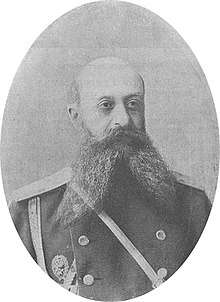Eduard Ekk
Eduard Vladimirovich Ekk (Russian: Эдуард Владимирович Экк; 11 April 1851 – 5 April 1937) was an Imperial Russian Army general of the infantry who held corps command during World War I.[1]
Eduard Vladimirovich Ekk | |
|---|---|
 | |
| Born | April 11, 1851 Saint Petersburg, Russian Empire |
| Died | April 5, 1937 Belgrade, Kingdom of Yugoslavia |
| Allegiance | Russian Empire |
| Service/ | Imperial Russian Army |
| Commands held | 71st Infantry Division (Russian Empire) 8th Infantry Division (Russian Empire) 7th Army Corps (Russian Empire) 23rd Army Corps (Russian Empire) |
| Battles/wars | Russo-Turkish War (1877-1878) Russo-Japanese War World War I Russian Civil War |
Biography
Born in the family of a privy councilor, received home education, entered the service in 1868 in the Life Guards Semyonovsky Regiment, was promoted to ensign in 1869. He graduated from the Nikolaev Academy of the General Staff in 1878. During the Russo-Turkish War (1877-1878), he was an assistant to the head officer over the column-guides of the army.
From 1879 to 1884 he was the headquarters officer for assignments at the headquarters of the Kharkov Military District, and from 1884 to 1887 - at the headquarters of the Moscow Military District.
From 1887 to 1895 he was the chief of staff of the 13th cavalry division. From 1895 to 1897 he was the commander of the 26th Mogilev Infantry Regiment.
In 1897 he was promoted to major general and appointed chief of staff of the 7th Army Corps.
In 1900 he was appointed assistant chief of staff of the Odessa Military District, in 1902 he became the duty general of the headquarters of the Odessa military district.
During the Russo-Japanese War, commanded the 71st Infantry Division, in December 1904 he was promoted to lieutenant general.
From 1906 he was the head of the 8th Infantry Division, from 1907 to 1912 he commanded the Grenadier Corps. In 1910 he was promoted to general from infantry.
Since 1912, he commanded the 7th Army Corps, at the head of which he met the First World War. It has established itself as an active comcor, combining a frontal strike with a flank bypass, and requiring subordinates to be energetic and actively maneuver. The corps of Ekk during the battles of the Battle of Galicia at Yanchin (on the Gnilaya Lipa River) August 16 - 17, 1914, having lost 200 people killed (6 officers and 144 lower ranks) and 1024 people wounded and missing news (a general, 22 officers, 941 lower ranks were wounded, 60 lower ranks were missing), defeated the Austrian 35th Infantry Division of the 12th Army Corps and 11th Infantry Division of the Kewess Army Group, capturing several thousand prisoners, 35 guns , 4 machine guns and a banner. He was awarded the Order of St. George 4th degree for the fact that in the battle of Lviv from August 25 to 30, 1914 he withstood the strong onslaught of the overwhelming forces of the enemy and on the first day of the battle he stopped the flinch units of one of the infantry divisions by personal example. In the September-October battles of 1915 on Goryn and Ikva, expelling the enemy from the Volyn province (for which Ekk was awarded the Order of St. George of the 3rd degree), the compound under the command of Ekk captured 285 officers, 14,590 lower ranks (and only healthy ones besides the wounded), 2 heavy guns, 6 bomb mortars, 2 mortars, 48 machine guns, and a lot of weapons and equipment.
Ekk participated in the Brusilovsky breakthrough, and in October 1916 took command of the 23rd Army Corps.
In the spring of 1917, he was "cleaned out" of the army by the Provisional Government and credited to the reserve at the headquarters of the Kiev Military District.
In the Volunteer Army since 1918, chairman of the military field court at the headquarters of the commander in chief of the Armed Forces of South Russia.
In exile in Yugoslavia. Head of the 4th Division of the ROVS, Chairman of the Council of the United Officer Societies. Initiator of the publication in Belgrade of the Russian Military Bulletin. In 1927 it was renamed the Tsar's Bulletin. He died in Belgrade.[2]
Awards
- Order of St. Stanislav, 3rd class with swords and bow (1879);
- Order of St. Vladimir, 4th class with swords and bow (1880);
- Order of St. Stanislav, 2nd art. (1883);
- Order of St. Anna, 2nd art. (1888);
- Order of St. Vladimir 3rd art. (1892);
- Order of St. Stanislav 1st Art. (1901);
- Order of St. Anna 1st Art. (1905);
- Order of St. Vladimir, 2nd art. with swords (1905);
- Golden weapon “For courage” (VP 18.06.1906);
- Order of St. George 4th Art. (VP 09/27/1914);
- Order of the White Eagle with swords (VP 06.12.1914);
- Order of St. Alexander Nevsky (1915) with diamond signs (1916);
- Order of St. George 3rd Art. (VP 03.06.1916);
- The highest favor (VP 08.09.1916).
- Order of St. Alexander, 3rd art. (Bulgaria).
References
- Deutsche Nationalbibliothek, Berlin State Library, Bavarian State Library, Austrian National Library //Общий нормативный контроль (GND) — 2012—2016.
- "Во главе «Генеральской Атаки»". btgv.ru. Retrieved 2020-01-17.
External links
- "Eduard Ekk". «Russian army in a Great war» project.
| Preceded by |
Commander of the 71st Infantry Division 1904-1906 |
Succeeded by |
| Preceded by |
Commander of the 8th Infantry Division 1906-1907 |
Succeeded by |
| Preceded by |
Commander of the 7th Army Corps 1912-1916 |
Succeeded by |
| Preceded by |
Commander of the 23rd Army Corps 1916-1917 |
Succeeded by |